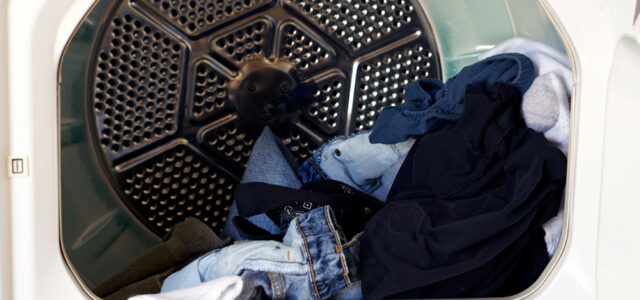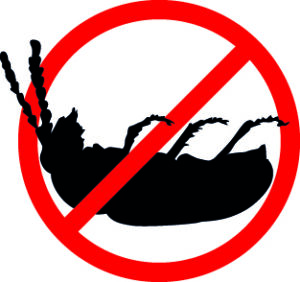Call for your appointment today 914-666-4665 | Mt. Kisco, New York

The aspiring young scientist, Jackie Flynn, reported that her informal study found ticks were killed after 5 minutes in the dryer, not one hour. The time difference was significant and caught the attention of researchers at the CDC, who decided to investigate further.
Now, three years later, a new study published in Ticks and Tick-borne Diseases has, in fact, found that it only takes 6 minutes to kill a tick in the dryer. [1]
The study’s lead author, Christina Nelson from the CDC, found the quickest method was to throw clothes directly into the dryer before washing them. Standard-sized, residential washers and dryers were used in the study.
“Placing clothing directly in a dryer and drying for a minimum of 6 minutes on high heat will effectively kill ticks on clothing,” reported Nelson. “If clothing is soiled and requires washing first, our results indicate clothing should be washed with water temperature [equal to or greater than] 54°C (≥130°F) to kill ticks.”
Nelson and colleagues also found that the water temperature of a wash would impact the survival rates of ticks. “Washing with hot water killed all nymphal and adult ticks when the water temperature was [equal to or greater than] 54°C (130°F).” [1]
It was more difficult to kill nymphal and adult ticks at lower temperatures. Nelson reported that half (50%) of the ticks survived hot water washes when the water temperature was less than 54°C (130°F).
And while cold water washes may be more gentler on your clothes, they also allow ticks to live on. “The majority (94%) of ticks survived warm washes [temperature range between 27–46°C (80–115ºF)] and all ticks survived cold washes [15–27°C (59–80°F)].”
If a tick survives a wash cycle it’s still possible to kill them in the dryer. But, the temperature must be even higher. “When subsequently dried on a high heat setting [54–85°C (129–185°F)], it took 50 minutes to kill all ticks (95% confidence limit, 55 minutes).”
[bctt tweet=”How to kill a tick on your clothes.” username=”DrDanielCameron”]
Nelson pointed out the majority of nymphal ticks did not survive beyond 30 minutes of drying time. Only one tick was found to survive at 40 minutes but subsequently died before the bag was rechecked at 50 minutes.
Nelson did not identify additional factors that may have contributed to killing the ticks including the effects of detergents or dryer sheets. Furthermore, killing other types of ticks might be more difficult, Nelson warned. “For example, Amblyomma americanum ticks (also known as lone star ticks) are more resistant to low humidity and would potentially survive longer in dryers.” [1]
 How did the authors know the ticks were truly dead?
How did the authors know the ticks were truly dead?
“Following each wash and dry cycle, tick survival was assessed by observing the ticks for normal behavior and movement,” stated Nelson. “If ticks appeared to be moribund and movement was not readily apparent, ticks were lightly probed with forceps, exposed to carbon dioxide through exhalation, and observed for several additional minutes.”
“To verify that motionless ticks were in fact dead and not simply stunned, ticks were then placed in petri dishes with a piece of wet paper towel and reassessed 20 to 24 hours later,” reported Nelson. [1]
So, how concerned should you be about ticks actually being on your clothes and potentially biting you and causing Lyme disease or other tick-borne infections? What are the odds that a tick has attached itself to your socks, pant legs or shirt while you were enjoying the great outdoors? Nelson and colleagues cited two studies which answer those questions. [1] And the odds are in favor of the tick.
“In one Maryland study, an investigator simulated outdoor activities such as gardening or clearing brush by crawling through leaf litter for 30-second time periods. I. scapularis nymphs were acquired in 58% of crawls, and the majority of ticks were found on pant legs and socks.” [2]
“In another study, investigators who walked a series of 100 meter transects through a wooded area in New Jersey found an average of nine I. scapularis adults on their clothing afterward.” [3]
Our takeaway from this long-overdue study by the CDC is to dry first, high heat, wash later. And skip the cold water washes. They may preserve your clothes but not necessarily your health.
References:
- Nelson CA, Hayes CM, Markowitz MA et al. The heat is on: Killing blacklegged ticks in residential washers and dryers to prevent tickborne diseases. Ticks Tick Borne Dis, 7(5), 958-963 (2016).
- Carroll JF, Kramer M. Different activities and footwear influence exposure to host-seeking nymphs of Ixodes scapularis and Amblyomma americanum (Acari: Ixodidae). J Med Entomol, 38(4), 596-600 (2001).
- Jordan RA, Schulze TL, Dolan MC. Efficacy of plant-derived and synthetic compounds on clothing as repellents against Ixodes scapularis and Amblyomma americanum (Acari: Ixodidae). J Med Entomol, 49(1), 101-106 (2012).




I’m thankful to see the CDC taking long overdue action on tick born illness risks.
Can unwashed clothing be put in the oven on a low temperature setting to kill ticks? This may be easier than using a dryer, e.g. for the disabled or those without dryers, and a pan is easier to clean afterwards than a dryer.
The dryer may work better as it dislodges ticks. But you never know.
Or put the clothes in a bag and leave in the freezer for 3 days. Everything will be dead assuming your freezer is near zero.
I am not so sure. 84% of ticks can make it through a typical Syracuse winter. Or check this out in Maryland. “Ticks were active many days during January and February, the coldest months, with some captures made when there was 70% snow cover and temperatures as low as -2 degrees C. Substantial numbers (70-90 ticks/h of flagging) of adult I. scapularis were captured on favorable days in January and February” You can read th the abstract at https://www.ncbi.nlm.nih.gov/pubmed/12693854
I am wondering about the effects of bleach on ticks – can they really be killed by bleach?
I have not read anything on the subject.
I found a tick on my coat in December while in the woods. It was cold and there was a light snow. Talbot County, Maryland
In the absence of a clothes dryer, what are your thoughts about using a hot dry iron to kill ticks that might be in clothing, ironing the clothing, slowly, both inside and out. Thank you.
Is it helpful to wear tick spray or tick collars on your boots while mowing lawn ?
Some of my patients do. I am not sure how effective they are. I advise a careful tick bite as a backup plan.
Did you mean “a careful tick CHECK as a backup plan”?
The combination would be better
I just found 2 ticks on me after being in the wooded area of my property. I removed the ticks, put them in a baggie and into the freezer. But then thought, “How do I know if they are on my clothes?” And here I am! My clothes were very soiled with red clay dirt in VA. So, I couldn’t put them in the dryer first. So, I took them outside, shook them vigorously and then straight into the washer. I used Clorox2 since they were colors. I used Lysol laundry sanitizer. Put them on warm wash, hot water would set the dirt stain and shrink the clothes, for an extended wash and extra rinse. Seems that even if I wash my clothes and if the ticks live, they will die when I put them in the dryer??
I’ve had chronic Lyme, 2 rounds of IV antibiotic therapy. And then was lucky enough to catch Rocky mounted spotted fever.
I tell everyone I know to make sure they bag and freeze the tick if they find one on them. Proof is in the tick if you happen to be like me and test negative for a year before being treated!
I would think washing the clothes followed by drying work. It just takes longer. Some of my patients send the tick through the mail.On the other hand, the tick test may not mean the infection has been transmitted. https://www.tickcheck.com/
Does dry cleaning kill ticks?
I feel sure I have an infestation of larval tick .how can I get rud of them on my body and furnishing
you could you tick for testing to determine the type of tick to guide your doctor.
https://www.tickcheck.com/
Speaking from experience, I would do longer than 6 minutes in the dryer at full heat. I laid in/on/around a wood tick nest a few days ago and google pulled up this website as a guide. Being paranoid, I did not do 6 minutes — I did 120 minutes on high heat. When I pulled out the lint trap after 120 minutes THEY WERE STILL MOVING.
These things are impossible to kill!! There was one on the floor that I tried to stomp and slide twice and it was still alive. Google says 72 hours in the freezer to kill. I ended up putting them in a ziplock bag, in a glass lock container and into the freezer. Vet’s will apparently also dispose of ticks (or at least the one here did).
It could be that 6 minutes was long enough to know the ticks off and leave them in the lint trap.
I just put them in a jar and pour boiling water on them… seems to work well.
I am not sure clothes intended for the washer will do well in boiling water.
There is a difference in the time it takes to kill ticks in a gas dryer and an electric dryer. We recommend drying the clothes first for 15 minutes on high in an electric dryer before washing the clothes. Less time would be required in an electric dryer.
Don’t flush ticks down the toilet. They will survive and remerge in the sewage treatment plant.
I am not so sure electric or gas is better.
My car is INFESTED with ticks. I rescued a hungry stray dog and put it in my car. It was nighttime, and I didn’t notice how infested it was. Every single inch of its body was covered in ticks. The next day, I brought it to the shelter as I could not handle that problem in my apartment. In the meantime, though my car is now infested with ticks. This is a huge problem because there are so many nooks and crannies in a car. Need advice.
If there were ticks you might have the car detailed after alerting them. A vacuum might help. You may consider leaving the car in the sun as ticks might die with the combination of heat and dryness.
I have always stuck ticks with a pin and burned them (this was taught when I was a child MANY years ago
Of course, burning isn’t cost effective when they are on clothing lol